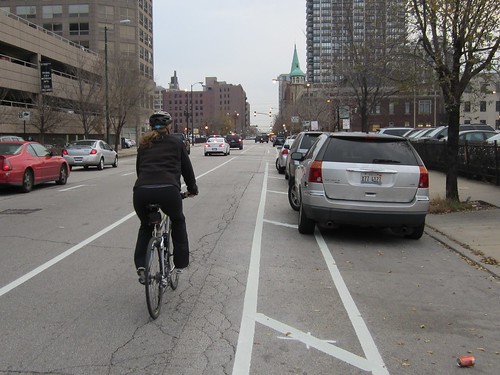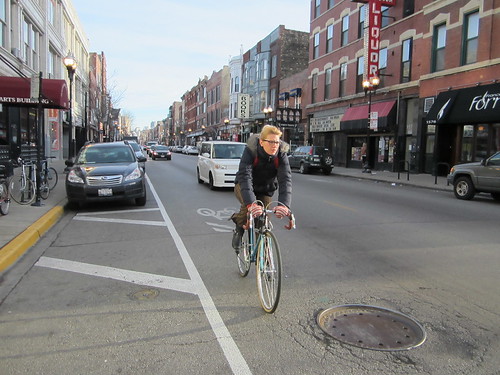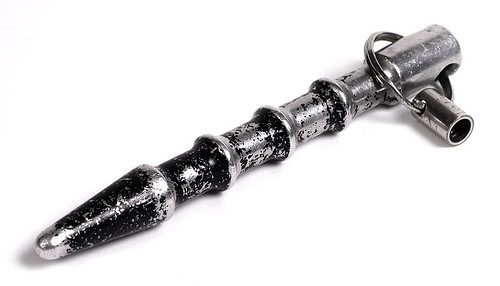After reading Allison Zmuda’s account of being attacked on her bike last month, fellow bicyclist Lauren Gill was inspired to take action, writing a guide to dealing with street harassment and crime for female cyclists. The tips for avoiding assault while riding are useful for everyone, and the piece also calls on men to help stop intimidation and violence against women on wheels.
At 5:30 a.m. on Sunday, February 24, Zmuda was pedaling downtown on Milwaukee Avenue in Wicker Park. South of Division Street, a young man stepped off the curb on the west side of the street. He yelled at her to give him the bike and shoved her rear wheel, causing her to fall. The assailant then grabbed her and pinned her against a nearby iron fence, choking her and demanding money. After she gave him the $20 in her pocket, he kissed her face and fled the scene.
View Larger Map
1100 block of North Milwaukee Avenue
Later that day, Zmuda shared her traumatic experience on The Chainlink, an online forum for local cyclists. “I just want to give you all a heads up of what happened in an area I usually feel safe in,” she wrote. “I was lucky and managed to keep everything that mattered to me and came away just really shaken up … Let’s look out for each other!”
Gill decided to do just that, posting the article “Take Back the Lane: A Guide to Street Harassment on Bicycle” a few days later on the website for Tiny Fix, an all-female bike gang. She writes that while she has been catcalled while riding by men in cars and has had fearful visions of having her wheel grabbed at a red light, “I naively assumed I was ‘too smart’ to actually fall prey to [violence].” That sense of security vanished after she read about Zmuda’s mugging on Chicago’s busiest bike street.
“This instance has had me thinking, especially with its pertinent closeness to my every day commuting route, that my safety net, my grand (delusional) idea of how I could and would handle myself is not enough,” Gill writes. Along with other Tiny Fix members and female friends, she compiled a list of strategies to head off attacks while riding alone at night or in high-crime areas.
She recommends riding in the center of the travel lane to get a better view of your surrounding and to avoid flats from curbside debris. Although she normally comes to a complete stop for all red lights, she advises doing the opposite when riding in the wee hours or on sparsely populated streets. Gill warns that the distraction of riding with headphones is especially dangerous at night, and she recommends having a self-defense weapon at the ready: keys, u-lock, or a miniature nightstick/keychain called a Kubotan. She also suggests doing research on the areas you’ll be riding through using the Chicago Police Department’s ClearMap crime location map, although she cautions against stereotyping neighborhoods as safe or unsafe.
Gill calls on men to do their part to create safer conditions for female cyclists by helping to change the culture of violence against women. “Every time you ignore or dismiss another’s abuse, is a time you are complicit in it,” she writes. She tells men to stop suggesting a victim was partly responsible for a crime because she was riding alone or at night, or because of what she was wearing. She asks them to call out harassment of women by friends, family and people on the street. "Explain why beeping a horn at a girl isn’t a modern-day mating call, but immediately triggers a fear that you might get hit by a car.”
She concludes by addressing men who would harass and threaten women on their bikes. “Cycling is already a vulnerable activity through which many people still find and source a great deal of strength,” she writes. “You don’t have a protective shell around you, but goddamnit you are powered by your own body … Don’t make women wish that they could take their body out of that very precious and beloved equation.”








